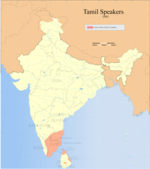
Back Tamils Afrikaans تاميليون Arabic تاميليين ARZ Tamillər Azerbaijani تامیللر AZB Halak Tamil BBC Тамілы Byelorussian Тамили Bulgarian তামিল জাতি Bengali/Bangla Tàmils Catalan
Tamilar | |
|---|---|
| Total population | |
c. 77 million  | |
| Regions with significant populations | |
| India | 69,026,881 (2011)[1] |
| Sri Lanka | 3,108,770 (2012)[2][note 1] |
| Malaysia | 1,800,000 (2016)[6] |
| United States | 238,699+ (2017)[7] |
| Canada | 237,890 (2021)[8][note 2] |
| Singapore | 174,708 (2020)[9][note 3] |
| Other | See Tamil diaspora |
| Languages | |
| Tamil | |
| Religion | |
| Majority: Hinduism Minority: | |
| Related ethnic groups | |
| Dravidians | |
| Tamiḻ | |
|---|---|
| People | Tamiḻar |
| Language | Tamiḻ |
| Country | Tamiḻ Nāṭu |
| Part of a series on |
| Tamils |
|---|
 |
|
|
The Tamils (/ˈtæmɪlz, ˈtɑː-/ TAM-ilz, TAHM-), also known as the Tamilar, [note 4] are a Dravidian ethnolinguistic group who natively speak the Tamil language and trace their ancestry mainly to the southern part of the Indian subcontinent. The Tamil language is one of the longest-surviving classical languages, with over two thousand years of written history, dating back to the Sangam period (between 300 BCE and 300 CE). Tamils constitute about 5.7% of the Indian population and form the majority in the South Indian state of Tamil Nadu and the union territory of Puducherry. They also form significant proportion of the population in Sri Lanka (15.3%), Malaysia (7%) and Singapore (5%). Tamils have migrated world-wide since the 19th century CE and a significant population exists in South Africa, Mauritius, Fiji, as well as other regions such as the Southeast Asia, Middle East, Caribbean and parts of the Western World.
Archaeological evidence from Tamil Nadu indicates a continuous history of human occupation for more than 3,800 years. In the Sangam period, Tamilakam was ruled by the Three Crowned Kings of the Cheras, Cholas and Pandyas. Smaller Velir kings and chieftains ruled certain territories and maintained relationship with the larger kingdoms. Urbanisation and mercantile activity developed along the coasts during the later Sangam period with the Tamils influencing the regional trade in the Indian Ocean region. Artifacts obtained from excavations indicate the presence of early trade relations with the Romans. The major kingdoms to rule the region later were the Pallavas (3rd–9th century CE), and the Vijayanagara Empire (14th–17th century CE).
The island of Sri Lanka often saw attacks from the Indian mainland with the Cholas establishing their influence across the island and across several areas in Southeast Asia in the 10th century CE. This led to the spread of Tamil influence and contributed to the cultural Indianisation of the region. Scripts brought by Tamil traders like the Grantha and Pallava scripts, induced the development of many Southeast Asian scripts. The Jaffna Kingdom later controlled the Tamil territory in the north of the Sri Lanka from 13th to 17th century CE. European colonization began in the 17th century CE, and continued for two centuries until the middle of the 20th century.
Due to its long history, the Tamil culture has seen multiple influences over the years and have developed diversely. The Tamil visual art consists of a distinct style of architecture, scultpure and other art forms. Tamil sculpture ranges from stone sculptures in temples, to detailed bronze icons. The ancient Tamil country had its own system of music called Tamil Pannisai. Tamil performing arts include the theatre form Koothu, puppetry Bommalattam, classical dance Bharatanatyam, and various other traditional dance forms. Hindusim is the major religion followed by the Tamils and the religious practices include the veneration of various village deities and ancient Tamil gods. A smaller number are also Christians and Muslims, and a small percentage follow Jainism and Buddhism. Tamil cuisine consist of various vegetarian and meat items, usually spiced with locally available spices. Historian Michael Wood called the Tamils the last surviving classical civilization on Earth, because the Tamils have preserved substantial elements of their past regarding belief, culture, music, and literature despite the influence of globalization.[10]
- ^ Census of India 2011 - Language Atlas (PDF). Government of India (Report). Archived (PDF) from the original on 2 April 2023. Retrieved 1 June 2024.
- ^ Census of Population and Housing of Sri Lanka, 2012 – Table A3: Population by district, ethnic group and sex (PDF). Government of Sri Lanka (Report). Archived from the original (PDF) on 24 September 2015. Retrieved 29 February 2016.
- ^ "A2: Population by ethnic group according to districts, 2012". Government of Sri Lanka. Archived from the original on 28 April 2017. Retrieved 19 May 2013.
- ^ Mohan, Vasundhara (1987). Identity Crisis of Sri Lankan Muslims. Delhi: Mittal Publications. pp. 9–14, 27–30, 67–74, 113–18.
- ^ "Analysis: Tamil-Muslim divide". BBC News. Archived from the original on 8 June 2014. Retrieved 6 July 2014.
- ^ Tamil at Ethnologue (19th ed., 2016)

- ^ "Commuting Times, Median Rents and Language other than English Use". Government of United States (Press release). 7 December 2017. Archived from the original on 21 October 2023. Retrieved 1 August 2022.
- ^ Knowledge of languages by age and gender: Canada, provinces and territories, census metropolitan areas and census agglomerations with parts. Government of Canada (Report). 17 August 2022. Archived from the original on 16 November 2023. Retrieved 12 October 2022.
- ^ Singapore Census of Population 2020, Statistical Release 1: Demographic Characteristics, Education, Language and Religion. Government of Singapore (Report). Archived from the original on 25 September 2023. Retrieved 13 September 2024.
- ^ Wood, Michael (2 August 2007). A South Indian Journey: The Smile of Murugan. Penguin UK. pp. x, xiii, xvi. ISBN 978-0-14193-527-0. Archived from the original on 14 September 2024. Retrieved 29 October 2020.
Cite error: There are <ref group=note> tags on this page, but the references will not show without a {{reflist|group=note}} template (see the help page).